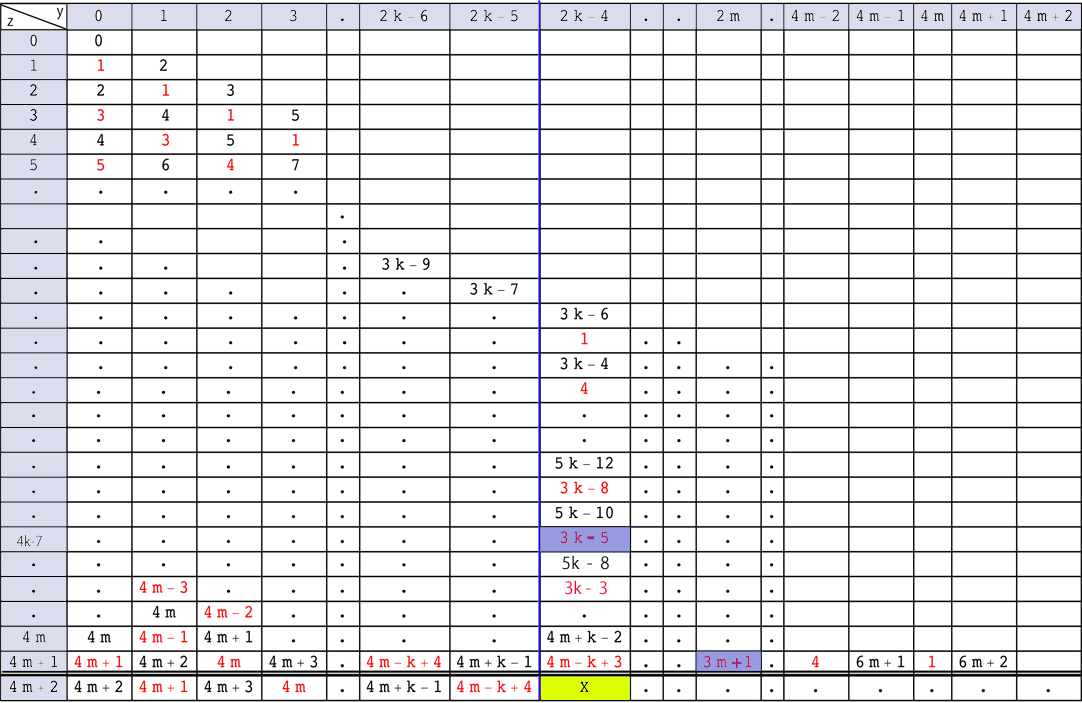Next: Case 2
Up:Abstract and the table of contents Previous: Some examples
Case 1
In this subsection we study the case that
 and
and  is even.
is even.
An example of this case is Example 5.3.
The argument here looks complicated, but it is a generalization of argument used in Example 5.3. If you read Example 5.3 and the proof here side by side, the logic we use looks clear enough.

In Fig. 5.19 we suppose that Predictions 5.1, 5.2, 5.3,5.4 and 5.5 are valid for
 and for
and for
 . We also suppose that these predictions are valid for
. We also suppose that these predictions are valid for  and
and
 . Under these assumptions we prove that
. Under these assumptions we prove that
 .
.
For
 by Prediction 5.1 the first number from the right end of the row is
by Prediction 5.1 the first number from the right end of the row is  .
If we start with
.
If we start with  and go leftward picking up every other number, then we have
and go leftward picking up every other number, then we have
 which is an arithmetic sequence with common difference of
which is an arithmetic sequence with common difference of  .
.
On the other hand if we start with  that is the second number from the right end of the row and go leftward picking up every other number, then we have an arithmetic sequence with common difference of
that is the second number from the right end of the row and go leftward picking up every other number, then we have an arithmetic sequence with common difference of  whose length is
whose length is

 , and hence the last number of this sequence is
, and hence the last number of this sequence is

 . This number
. This number  is the first number of an arithmetic sequence with common difference of
is the first number of an arithmetic sequence with common difference of  and the last number of this sequence is
and the last number of this sequence is  .
.
By Prediction 5.5 for
 the number at the top of the column is
the number at the top of the column is

 . If we move down picking up every other number, then we have an arithmetic sequence with common difference of
. If we move down picking up every other number, then we have an arithmetic sequence with common difference of  .
.
On the other hand if we start with 1 that is the second number of the column and move down picking up every other number, then we have
 that starts as an arithmetic sequence with common difference of
that starts as an arithmetic sequence with common difference of  such that it has
such that it has

 terms and the last number is
terms and the last number is
 , then after this number it becomes an arithmetic sequence with common difference of
, then after this number it becomes an arithmetic sequence with common difference of  whose first number is
whose first number is  , and after that we have
, and after that we have
 .
.
In Fig. 5.19 we assume that
 |
(5.30) |
 |
(5.31) |
 and and  |
(5.32) |
Note that
 and
and
 are printed in red on blue rectangles in Fig. 5.19.
These two Grundy numbers are important, because
are printed in red on blue rectangles in Fig. 5.19.
These two Grundy numbers are important, because
 is the last term in the arithmetic sequence of common difference of 3 in the row when
is the last term in the arithmetic sequence of common difference of 3 in the row when  , and
, and
 is the last term in the arithmetic sequence of common difference of 3 in the column when
is the last term in the arithmetic sequence of common difference of 3 in the column when  .
By (5.30) and (5.32)
.
By (5.30) and (5.32)
 is under Grundy number
is under Grundy number
 , and it is on the right side of Grundy number
, and it is on the right side of Grundy number
 .
By Lemma 5.1 we have only to prove that
.
By Lemma 5.1 we have only to prove that  is the smallest number that does not belong to
is the smallest number that does not belong to
 , if we are to prove that
, if we are to prove that
 .
.
By Definition 5.2
 can be separated into three parts
can be separated into three parts
 ,
,
 and
and
 .
.

 |
(5.33) |


 |
(5.34) |
 |
(5.35) |
 |
(5.36) |
By using predictions for  and
and



 |
(5.37) |
 |
(5.38) |
By (5.33) and (5.34) we have
 |
(5.39) |
By (5.35) and (5.36)
we have
 |
(5.40) |
By (5.37) and (5.38)
 |
(5.41) |
By (5.39), (5.40) and (5.41) we have
 and
and  is the smallest number that does not belong to
is the smallest number that does not belong to
 . Therefore
. Therefore
 .
.
Next: Case 2
Up:Abstract and the table of contents Previous: Some examples

